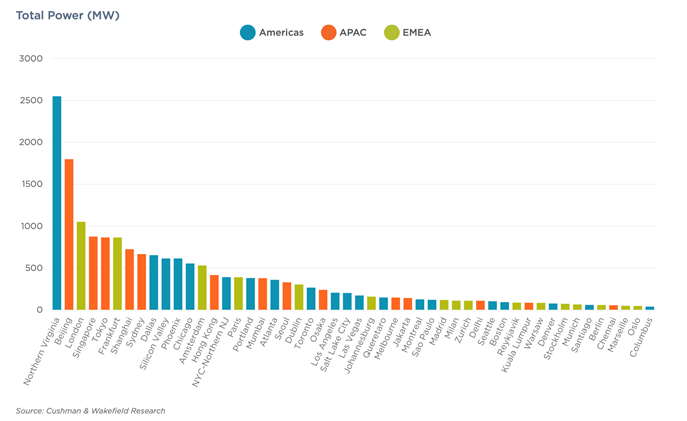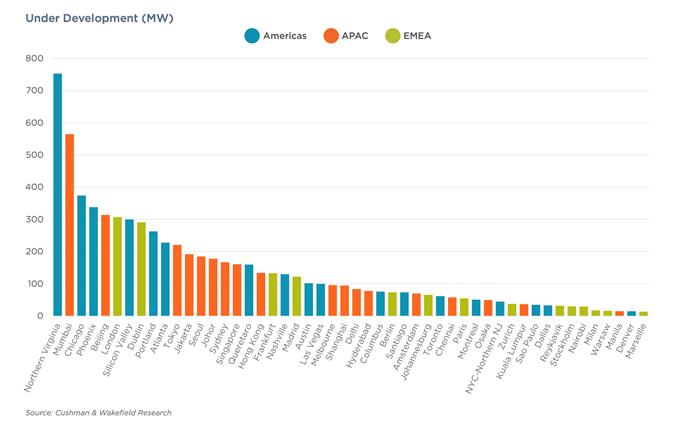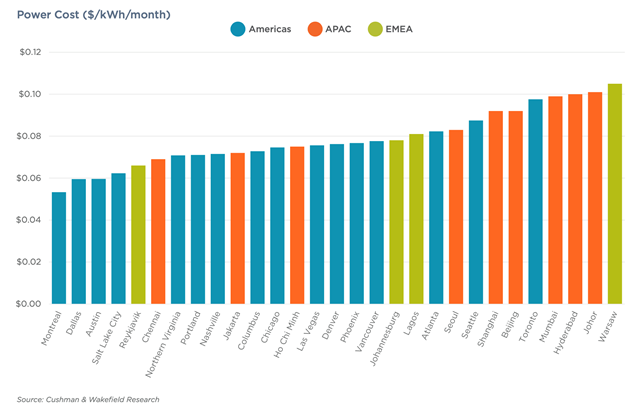Data centres: A 24hr power source?
Data centres play a critical role in enabling the storage and processing of vast amounts of online data. However they are also known for their significant energy consumption, which has raised concerns about their environmental impact and operating costs.
But can data centres be fully sustainable, or even a source of power? Here we take a look…
Data centres: Continued growth
Data centres house computer servers, storage devices, and the networking and infrastructure required to support digital services. That means every website, search, post, swipe and stream are all powered by data centres.
Trends that began pre-Covid and fuelled during the pandemic (like cloud-based computing) have continued to move forward; data is being generated and stored at record levels (previously covered here) and as technology continues to evolve with rapid advances in AI, global demand for data centre facilities continue to rise. This increase in demand means that there is an ever-growing pipeline for data centre developments globally.
Cushman & Wakefield’s recent report ‘Global Data Centre Market Comparison’, tracks this growth and shows that former secondary and tertiary data centre markets across the globe have rapidly scaled-up to meet demand. In its first 2021 edition, Cushman & Wakefield tracked 1.6 GW of data centres under construction across 38 markets profiled. This grew to 2.9 GW in 48 markets in 2021, while 2022 increased to 4.1 GW currently under construction in 55 markets. Now, in 2023, the company reports there are 7.1 GW under development across 63 markets.
But even with this growth, findings from CBRE shows a global shortage of available power is inhibiting growth of the data centre market:
“Sourcing enough power is a top priority of data centre operators across North America, Europe, Latin America and Asia-Pacific. Certain secondary markets with robust power supplies stand to attract more data centre operators … Despite new development, vacancy rates are declining in all four regions due to strong demand,” CBRE says.
Cushman & Wakefield back this up, saying that the “appetite for new capacity from hyperscale cloud services remains unsated”. According to its report, Northern Virginia is the largest market globally, with almost 2.5 GW of data centres currently operational. While for the Asia Pacific region, data centres in Beijing, Shanghai, Singapore, Sydney and Tokyo account for 62 per cent of operational capacity. Cushman & Wakefield predicts that Sydney and Tokyo are likely to join Beijing and Shanghai as cities with more than 1 gigawatt of operational capacity within the next two years.
Figure 1: Data centre market size

Figure 2: Data centres under development (MW)

Energy efficiency and power costs
Data centres rely on an ecosystem of fiber networks, electricity grids, backup supplies, interconnections, and software - and consume a significant amount of energy to power and cool its infrastructure.
According to ADP Consulting, data centres are among the most energy and water intensive infrastructure assets, with around 40 per cent of the average facility’s power spent just on the task of cooling:
“A large data centre can consume the equivalent energy to 50,000 homes. Cooling the rows and racks of powerful computers also requires up to 19 million litres of water a day – a similar quantity of water to that consumed by a small city of 50,000 people,” ADP states.
Operators are continually working to improve data centre energy efficiency through advanced cooling techniques and energy-efficient hardware. Some ‘Green Data Centres’ are specifically designed to minimise their carbon footprint, by using renewable energy sources like solar and wind power, as well as efficient cooling and responsible waste management practices.
“With 2030 net-zero goals on the very near horizon, many hyperscale self builds and larger-scale developments are being paired with new renewable energy infrastructure development. In multiple instances, wind and solar farm sites have been developed alongside 100MW+ deployments. The ability to build out energy infrastructure such as these is becoming more a point of evaluation for the largest facilities,” Cushman & Wakefield reports.
According to Cushman & Wakefield, data centre power costs have substantially increased over the past year, with global markets experiencing a median 16 per cent growth in electricity costs. However, these increases have not been even, with some markets experiencing no change while others have seen up to 50 per cent year-on-year price growth. The current top ten are a mix of low-cost hydropower markets (Montreal, Portland, Reykjavik) and larger markets with diverse and plentiful power generation from both renewable and traditional sources (figure 3).
Figure 3: Power cost ($/kWh/month)

Data centres: A reliable source of power?
Anyone with an overactive iPhone knows it can run hot. Rising demand for data centres creates an opportunity for the power-hungry facilities to supply heat to neighbouring buildings and precincts.
Advanced technologies, such as thermoelectric generators or organic Rankine cycle (ORC) systems, can convert waste heat directly into electricity. Data centres can employ such technologies to harness their waste heat for power generation.
A recent report from ADP Consulting, Think… Liquid cities, states that while most buildings consume energy in peaks and troughs depending on the time of day, in contrast, data centres typically deliver a constant output.
The potential in recovering heat from data centres is being recognised across Europe, where political and regulatory pressure is starting to converge on heat recovery as a key lever to achieve truly sustainable data centres. In the Digital Decade strategy, the EU states that it should take the lead in making data centres climate neutral and energy efficient by 2030, and that the excess energy of the data centres should be recovered.
Global engineering company Danfoss agrees, stating in a recent report that excess heat - like the heat emanating from appliances - is the world’s “largest untapped energy source”. According to its findings, the EU wastes 2,860 TWh a year in excess heat, corresponding almost to the EU’s total energy demand for heat and hot water in residential and service sector buildings:
“Recycling heat is not only an overlooked measure in the current energy crisis, but also the next frontier of the green transition,” Danfoss states.
“We already have the solutions available today - what we need now is the political will to make it happen. The greenest, cheapest, and safest energy is the energy we don’t use.”
In some places, such technology is already in use. Technological University Dublin uses the excess heat from an Amazon data centre to heat its student accommodation. While in Norway, the world’s first land-based lobster farm uses heat from a data centre to heat the water it grows lobsters in. In October 2022, Facebook’s parent company Meta announced a roadmap for a gradual shift to a water-cooled AI infrastructure.
Regulations and standards
Global governments and industry organisations have developed various regulations, sustainability certification programs exist, and some EU member states offer tax incentives, grants, or subsidies to data centers that invest in energy-efficient technologies or renewable energy sources.
While efforts to reduce the energy consumption and environmental impact of data centres in Australia are in line with global trends toward energy efficiency, Walt Coulston, chief executive of GreenSquareDC, said Australia was “lagging in its ability to use data centres as a source of energy, but it would become necessary to do so”.
As technology continues to evolve - and data centres continue to grow - facilities in Australia will need to adopt more innovative solutions to further reduce their energy use.
The Australian Government has initiatives aimed at promoting data centre energy efficiency and sustainability, which includes energy efficiency standards for adopting renewable energy sources. While the source of electricity can significantly impact the carbon footprint of a facility, the location of a data centre within Australia can influence its energy use; the government guide states power purchase agreements for offsite renewable energy may instead be viable for some locations to reduce costs.
A “radical move”
While ADP Consulting describes establishing a network of pipes to transport heated water from data centres to nearby buildings as “a radical move”, it also believes it’s a move that could convert data centres from being perceived as a consumer to a generator. Data centres could play a role in Australia’s evolving energy mix, but would “require careful planning, coordination and consideration of technical and regulatory issues”.
But could Australia make it work? ADP floats some ideas on where to start; according to the report:
- Start the evolution early: The biggest obstacle to liquid cities is the infrastructure requirements - building owners may not be ready today, but that doesn’t mean you can’t provision the pipes and space for tomorrow.
- Re-design regulation: Existing regulations do not accommodate a utility which provides district heating and cooling systems. Safety, environmental and efficiency standards must evolve, as well as guidelines for heat transfer, thermal energy pricing and allocation. Australia will need a new regulatory body to assist with an energy transfer not of electricity or gas, but of hot and cold water.
- Incentivise liquid cooling-ready developments: Councils can incentivise provisions for district heating and cooling systems by offering height bonuses or other planning benefits when developers accommodate connections and space now. Precinct-scale projects around Australia are already planning for a future climate with adaption and resilience strategies that stretch out to the end of the century, the same could be done with liquid cooling-ready developments.
- Forge partnerships: Collaborations between precinct owners, local authorities, data centre operators and energy utilities will take years to bear fruit, but strong foundations can be forged today.
- Build the buzz: Conversations with the community can start today by sharing the benefits of liquid cooling to tackle several challenges in tandem, like climate action, energy security and affordable living.
Related Analysis
Data Centres and Energy Demand – What’s Needed?
The growth in data centres brings with it increased energy demands and as a result the use of power has become the number one issue for their operators globally. Australia is seen as a country that will continue to see growth in data centres and Morgan Stanley Research has taken a detailed look at both the anticipated growth in data centres in Australia and what it might mean for our grid. We take a closer look.
Carbon Capture Storage – A viable option for Australia’s future?
Carbon Capture and Storage (CCS) is increasingly being seen as a vital piece to our emissions reduction puzzle, with governments and industry seeing it as viable way to reach Net Zero. Australia currently has 18 CCS projects at various stages of progress, with only one operational - Chevron’s Gorgon Gas Plant in Western Australia, which has been plagued with problems since the start. We take a deep dive into CCS and whether it can be a feasible option for the future.
A peek at community attitudes and awareness towards the energy transition
Recent surveys from KPMG, SEC Newgate and the CSIRO have all provided good insights into the community’s attitude to the changes underway in the grid and the way we generate electricity. They also highlight the level of knowledge of what this involves as well as how overall views on the speed of the transition are being influenced by factors like cost-of-living pressures. We take a look at what they found.
Send an email with your question or comment, and include your name and a short message and we'll get back to you shortly.


